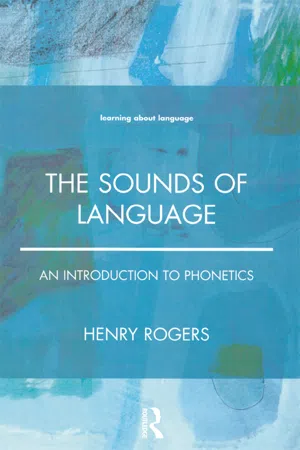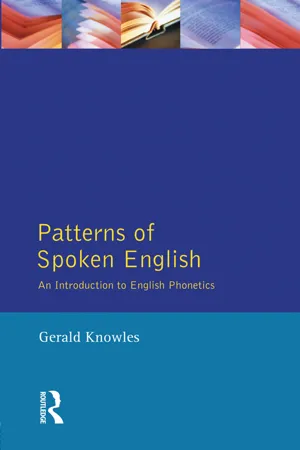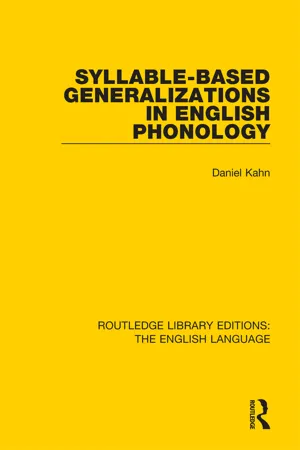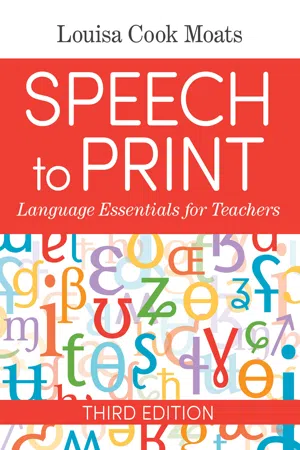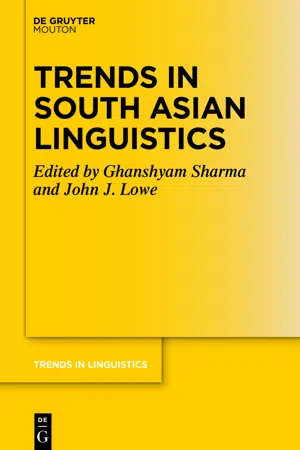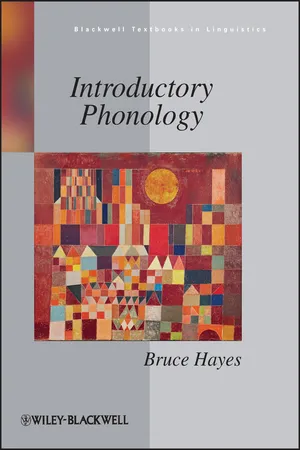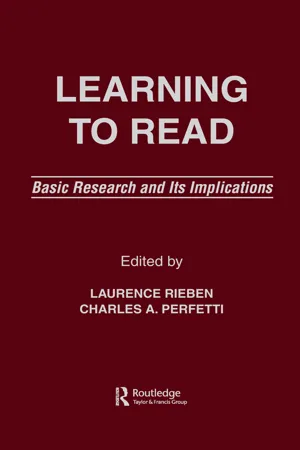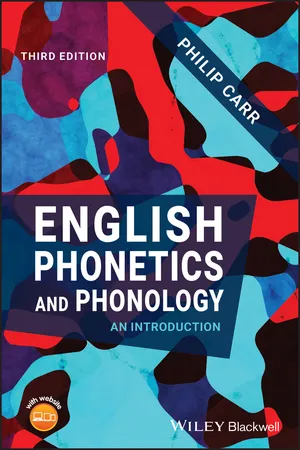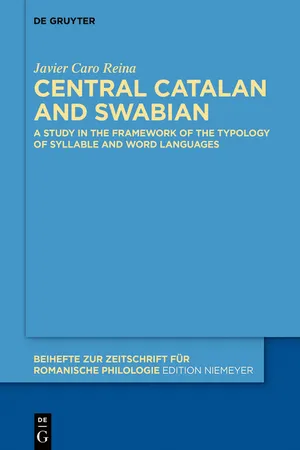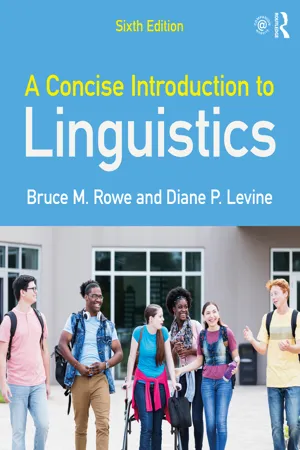Languages & Linguistics
Syllable
A syllable is a unit of sound in spoken language, typically containing a vowel sound and possibly one or more consonants. It is a fundamental building block of words and is important in understanding the rhythm and structure of language. Syllables are often used in linguistic analysis to study phonology and phonetics.
Written by Perlego with AI-assistance
12 Key excerpts on "Syllable"
- eBook - ePub
- John A. Goldsmith, Jason Riggle, Alan C. L. Yu, John A. Goldsmith, Jason Riggle, Alan C. L. Yu(Authors)
- 2011(Publication Date)
- Wiley-Blackwell(Publisher)
1The Syllable is one of the oldest constructs in the study of language, and most studies of phonology have found a place for the Syllable within them. The momentous reconstruction of the behavior of Indo-European sonants, which was the greatest accomplishment of nineteenth-century linguistics, was intimately linked to the realization that certain segments could be realized in strikingly different ways, depending on the location in which they appeared in their Syllable: elements that could be identified as glides, nasals, and liquids would be realized as consonants in some contexts, but in others, when a vowel was not present for morphophonological reasons, the segment would be realized as a syllabic peak. Working out the solution to problems of historical linguistics led directly to the development of new conceptions of phonological structure, a historical event that has not yet been completed. This chapter is an overview of the evolution of the discipline’s thought on this subject.Tradition has it that a Syllable consists of a vowel, usually preceded by one or more consonants, and sometimes followed by one or more consonants. In the overwhelming majority of spoken languages (though perhaps not all),2 the Syllable plays an important role in analyzing phonological regularities that phonologists have placed at the center of the phonological stage. The Syllable is, first of all, important for the expression of statements of phonotactics, the principles of a language that describe which strings of basic sounds are found. Why does blick appeal to the anglophone more than bnick ? It is, additionally, relevant for the expression of phonological conditioning for the realization of the basic sounds: the description of the realization of a t in American English is far more compact if the description can use the notions of “Syllable onset” and “Syllable coda” than if it is forced to forego them. Finally, there are few languages in the world whose prosodic systems can be adequately and compactly characterized without making reference to the Syllable.3 - eBook - ePub
The Sounds of Language
An Introduction to Phonetics
- Henry Rogers(Author)
- 2014(Publication Date)
- Routledge(Publisher)
14 Syllables and suprasegmentals DOI: 10.4324/9781315838731-14The segments of a language are the consonants and vowels. The suprasegmentals comprise several linguistically important phenomena which are not segmental, such as length, stress, pitch, and intonation. The term suprasegmental derives from the fact that these elements often extend over a string of segments. Suprasegmentals are often defined in terms of Syllables, so we will begin with a general consideration of the Syllable.In this chapter you will learn about:- the nature of the Syllable;
- long vowels and consonants;
- the use of pitch in speech;
- metrical theory of stress.
Syllable
The Syllable is a phonological unit of organisation containing one or more segments. Syllables are found in all languages; that is, all languages organise sounds in terms of Syllables. They are usually easy to count. Almost everyone will agree that the words book, table, carnation, particular, lackadaisical, and compatibility have one to six Syllables, respectively. Even in a language which you do not know, you can often count the Syllables in a word.Although it may be easy to count Syllables, it is not always easy to divide a word into Syllables. The word kidnap has two Syllables. Almost all English speakers will divide those Syllables as The word very also has two Syllables, but it is difficult to know where to divide it. Neither nor seems satisfactory, or, in another sense, both seem satisfactory.Structure of the Syllable
In Chapter 5 , we learned the basic terms for parts of the Syllable; they are shown here again in Figure 14.1 . A lower-case Greek sigma [s] is often used as a symbol for a Syllable. Typically, the nucleus of a Syllable is the vowel; the onset is the preceding consonant, and the coda is the consonant after the vowel. Together, the nucleus and the coda form the rhyme.Figure 14.1 Structure of the SyllableAny of these elements may branch, that is, have more than one unit. In fling, the onset branches; in belt, the coda branches (Figure 14.2 - eBook - ePub
Patterns of Spoken English
An Introduction to English Phonetics
- Gerald Knowles(Author)
- 2014(Publication Date)
- Routledge(Publisher)
CHAPTER 4The SyllableIn previous chapters we have examined sounds one at a time. We shall now turn to the groups and combinations into which sounds enter in connected speech. The smallest such group is the Syllable. Since the concept of the Syllable is a familiar and everyday one, it might be expected that linguists had long since agreed what the Syllable is, and how and why sounds group themselves into Syllables. In fact this is not so. The Swiss linguist de Saussure in his Course in General Linguistics , which was first published in French in 1916, suggested that the Syllable was based on the opening and closing of the vocal tract as the speaker moved from one sound to the next. This idea has an elegant simplicity which must be substantially correct. But as de Saussure himself pointed out, this basic idea does not account for all the patterns we might regard as Syllables. We shall therefore start with the basic Syllable and deal with the complications later.4.1 The principle of the SyllableThe chief criterion which governs the division of a string of phonemes into Syllables is the size of the oral cavity required for the different sounds. The SYLLABIC is the most open sound, generally a vowel. You can as a rule count the number of Syllables in a word or phrase by counting the number of vowel phonemes. The segment at the Syllable boundary is the closest sound. Any sounds between the boundary segment and the syllabic are arranged in order of increasing cavity size, and if any sounds follow the syllabic they are in decreasing order of cavity size.There are no generally agreed symbols for marking the parts of a Syllable, and what conventions there are arbitrary, untidy and unsystematic. A vertical dash is used in British works to mark the syllabic when it happens to be a consonant, e.g. button /bʌtņ/. But since in the opening sequence each segment has an aperture LESS THAN the next, we1 could use the symbol ‘<’ between each pair of segments, and similarly in the closing sequence, where each segment is GREATER THAN the next, we could use the symbol ‘>’. These symbols enable us to indicate the opening and closing of the Syllable, e.g. drunk - Daniel Kahn(Author)
- 2015(Publication Date)
- Routledge(Publisher)
To summarize the main point of these remarks, even the most concrete of the phonological levels, that of phonetic representation, is related to the acoustic signal by an extremely complex set of context-dependent rules. A phonetic representation does not capture the elementary physical attributes of an utterance directly, but rather encodes them in a way intimately tied up with the language capabilities of the human being.With these considerations in mind, let us turn to the notion of syllabic structure. The first thing to be noted is that it is not a fair challenge to the linguist who would divide utterances into "Syllables" at the phonetic level to demand instrumental proof of "Syllable boundary." The relevant observation is rather that the notion of "Syllable"as a Phonetic unit is meaningful to the naive speaker and to the phonetician in the same way that the concept [b] comprising the rising- and falling-formants variants is. Abercrombie says (1967:34):3One unit seems an obvious starting point for this purpose (analyzing speech -DK), and that is the Syllable. Most people seem to be able to say, without much difficulty, how many Syllables are contained in a word or utterance; and with perhaps somewhat more difficulty, to say where each Syllable begins and ends... The Syllable would appear to be an intuitively recognizable unit even for primitive peoples.We might ask why speakers and phoneticians perceive Syllables. Again it is helpful to consider this question first with respect to a less controversial phonetic unit like [b]. Obviously one thing that rising- and falling-formants [b]s have in common is that they correspond to the same articulatory gesture, bilabial closure with voicing and closed velum, and it is reasonable to assume that this is what is behind our regarding initial and final [b] as the same segment.Phoneticians have suggested such an articulatory correlate for the Syllable. According to Pike (1947:60), phonetic Syllables are "units of one or more segments during which there is a single chest pulse and a single peak of sonority or prominence." Similarly, for Abercrombie (1967:35) "each contraction (of the respiratory muscles), together with the resulting puff of air, constitutes the basis of the Syllable."- eBook - ePub
Speech to Print
Language Essentials for Teachers
- Louisa Cook Moats(Author)
- 2020(Publication Date)
- Brookes Publishing(Publisher)
Any phonological system has rules or constraints governing the way in which Syllables can be structured and phonemes can be sequenced within and across Syllable boundaries. These rules distinguish one language from another. The sections below delve into complexities of Syllable structure and stress patterns, including the internal structure of spoken Syllables; how Syllable boundaries in speech differ from Syllable boundaries in print; the distinction between simple and complex Syllables; and stress and intonation patterns, as well as how to teach Syllable awareness.The Internal Structure of Spoken SyllablesWords comprise phonemes, but those phonemes are organized into coarticulated units, called Syllables, that always have a vowel sound. A Syllable, by definition, is a unit of speech organized around a vowel. A spoken word always has at least one Syllable because it always has at least one vowel sound. The number of Syllables is equivalent to the number of vowel sounds in the word.Syllables have an internal structure (see Figure 3.1 ). They are more than strings of phonemes. The vowel in each Syllable is called its peak. The peak carries the most vocalic resonance or sonority. The onset of the Syllable is what, if anything, comes before the vowel. The rime is the vowel plus any consonants that come after it within the Syllable. Note that the term rime is a noun that refers to a linguistic unit, and it is distinct from the activity of rhyming or from poetic rhyme.Figure 3.1 .Syllable structure in the word “trust.”Syllables do not always have an onset; for example, the words egg and itch do not have an onset and are structured as rimes. A Syllable always has a rime because the rime includes the vowel; it is not possible to have a Syllable without a vowel sound. The consonants that follow the vowel in the rime are usually called the coda. For example, the Syllable trust has an onset [tr] and a rime [ʌst] and a coda [st]. The vowel /ʌ/ is the peak. Table 3.1 - eBook - ePub
- Ghanshyam Sharma, John J. Lowe, Ghanshyam Sharma, John J. Lowe(Authors)
- 2021(Publication Date)
- De Gruyter Mouton(Publisher)
Vennemann 1968 ).In addition to the linguistic evidence, there has been considerable evidence for Syllables from psycholinguistic studies. These studies can be divided broadly between speech error analysis, chronometric data, frequency studies and language games. We will focus on speech errors and chronometric experiments as they are the major informants of the primary speech production models. Speech errors often – but not always – involve the movement or exchange of phonemes or phoneme sequences. Shattuck-Hufnagel (1983) , Laubstein (1987) , and Davis (1988) provide evidence from English speech errors to support the view of syllabic constituents. Davis (1988) in particular shows transpositions where Syllable-initial segments, vowels and Syllable-final segments exchange with their counterparts but it is extremely rare for Syllable onsets and codas to exchange positions between each other (MacKay 1972 ; Motley 1973 ; Nootboom 1969; Shattuck-Hufnagel 1979 ). It is also interesting to note that segment sequences that cross Syllable boundaries do not move together (Shattuck-Hufnagel 1983 ). Laubstein (1987) demonstrates, based on her investigations into naturally occurring speech errors, that while there was evidence for onset, peak and coda divisions, there was no evidence for the rhyme. Therefore, evidence for the internal structure of Syllables is mostly derived from linguistic evidence. Meyer (1992) - eBook - ePub
- Bruce Hayes(Author)
- 2011(Publication Date)
- Wiley-Blackwell(Publisher)
13 Syllables13.1 Syllables in Phonological Theory
Among phonological entities, Syllables are unusual in the degree to which they stand out to the native speaker at the conscious level. It is relatively easy for people to count the Syllables of a word – much easier than counting the segments. People also find it intuitive to count out Syllables and arrange them in time whenever they use them in verse, chant, and song.Looking within phonology itself, we find that Syllables frequently appear in environments of phonological rules, both for deriving allophones and in morphophonemic alternation. Syllables also are the units that bear stress (chapter 14) and serve as the “anchor points” for tones in tonal systems and in intonation (chapter 15). It is hardly surprising that phonologists have often made use of Syllables in phonological theory.13.2 Representation
Various means are used to depict Syllables formally. In the International Phonetic Alphabet, Syllables are shown by separating them with a boundary symbol, specifically a period; thus, connective is represented with its syllabification as [kə.nεk.tI v]. Another approach, followed here, eschews boundary symbols and assumes instead that Syllables are phonological constituents. For representing such constituency, the clearest notation is tree structure. In the representation for connective below, the Syllable constituents are labeled with /σ/ (Greek sigma, for “Syllable”):A more concise notation uses brackets, annotated with σ: [σ kə]σ [σ nεk]σ [σ tI v]σ or, still more concisely, [kə]σ [nεk]σ [tI v]σ . The full tree notation will be used here for phonological derivations in which segments get added to or removed from Syllables, or for cases where brackets must be reserved for morphological or syntactic structure.In discussing Syllables, it is useful to be able to refer to certain substrings of them. The onset of a Syllable is defined as the consonant or sequence of consonants at the beginning of a Syllable. The coda is the consonant or sequence of consonants at the end of a Syllable. The nucleus of a Syllable is the vowel or diphthong found at the Syllable’s core and functioning as its sonority peak (sometimes peak - eBook - ePub
- Javier Caro Reina, Renata Szczepaniak, Javier Caro Reina, Renata Szczepaniak(Authors)
- 2014(Publication Date)
- De Gruyter(Publisher)
Javier Caro Reina (University of Freiburg) and Renata Szczepaniak (University od Hamburg)Introduction: Syllable and word languages
The phonological typology of Syllable and word languages is a prosodically-based model. It focuses on the question of which prosodic category is central for the phonological make-up of a particular language and how the central prosodic category influences the Syllable structure, the distribution of the phonetic and phonemic inventory, and phonetic and phonological processes. The differentiation between two prototypes – the Syllable language and the word language – is based on an empirical study carried out by Auer (1993). On the basis of a sample containing 34 geographically and genetically different languages, he observes that most of the languages examined tend to have one central prosodic category, either the Syllable or the phonological word. This category is used as the domain for phonetic and phonological processes. The existence of a central prosodic domain manifests itself in a series of cross-linguistic correlations of phonetic and phonological characteristics. For example, Syllable complexity correlates positively with word-related phonotactic restrictions and processes, but negatively with tone and Syllable-related processes while tone and vowel harmony mostly occur in languages with no or only vague word accent (see Auer 1993: 88). Therefore, phonological properties are not arbitrary, but cluster reflecting the grade of relevance of both (as well as other) prosodic categories in a particular language.The phonological typology of Syllable and word languages must be kept apart from the phonetic distinction between Syllable-timed and stress-timed languages, also known as the “isochrony hypothesis” – one of the earliest attempts to develop a speech-rhythm based classification. It not only gave rise to a series of experimental studies, but was also the starting point for the rhythm class hypothesis as well as the phonological typology of Syllable and word languages. - eBook - ePub
Learning To Read
Basic Research and Its Implications
- Laurence Rieben, Charles A. Perfetti(Authors)
- 2013(Publication Date)
- Routledge(Publisher)
11 The Role of Intrasyllabic Units in Learning to Read
Rebecca Treiman Wayne State UniversityDOI: 10.4324/9781315044453-14Introduction
As many investigators (e.g., Gough & Hillinger, 1980 ; Liberman, 1982 ) have pointed out, children's knowledge of spoken language plays an important role in their acquisition of written language. Because writing systems reflect spoken language, studies of language structure provide an important foundation for studies of how children learn to read. This chapter focuses on one specific aspect of spoken language structure—phonological units that are intermediate in size between Syllables and phonemes. After reviewing the linguistic status of these intrasyllabic units, I discuss their role in the development of phonological awareness and the learning of reading. Implications for reading instruction are also considered.Linguistic Views of Syllable Structure
Until relatively recently, the Syllable was little discussed within linguistics. Some linguists mentioned the Syllable only to ignore it; others asserted that the Syllable played no role in phonological organization. Recently, however, there has been increased attention to Syllables and their structure. In one view (e.g., Hooper, 1972 ), the Syllable is a linear string of phonemes. There are no levels of structure intermediate between the Syllable and the phoneme. Another view (e.g., Fudge, 1969 ; Hockett, 1967/1973 ; Selkirk, 1982 ) holds that the phonemes within a Syllable are organized hierarchically. There exist phonological units that are intermediate in size between Syllables and phonemes. The linguists just cited postulate two major subunits of the Syllable, the onset and the rime. The onset, or initial consonantal portion of the Syllable, is a single consonant or consonant cluster. The rime is the vowel and any following consonants. Thus, the word blast has the onset/bl/ and the rime /æst/.Much of the evidence for onset and rime units comes from English. For English, there are several converging lines of evidence, including constraints on the distributions of phonemes within Syllables, errors in the production of speech, natural and experimental word games, and errors in short-term memory for spoken Syllables. This evidence is reviewed by Treiman (1988 - eBook - ePub
English Phonetics and Phonology
An Introduction
- Philip Carr(Author)
- 2019(Publication Date)
- Wiley-Blackwell(Publisher)
7 English Syllable Structure 7.1 Introduction We have said morphemes are a kind of mental representation which have three properties: a syntactic category, a meaning and a phonological form. We have allowed, thus far, that the phonological form of a morpheme is present in the speaker’s mentally constituted grammar, and that this phonological form consists in either a single phonological segment or a sequence of such segments. But this is only part of the story: there is more to the phonological form of a morpheme than that. There is evidence that those segments are organized into phonological constituents, rather in the way that words are organized into syntactic constituents (such as phrases and sentences). One of those constituents is the Syllable. The evidence for the existence of the Syllable comes largely in the form of phonological generalizations which cannot be adequately expressed without reference to the notion ‘Syllable’. The aim of this chapter is to examine the structure of the Syllable in English, and exemplify some of the sorts of phonological generalization which are best expressed in terms of that structure. 7.2 Constituency in Syllable Structure The two main constituents within a Syllable are the onset and the rhyme. In the word bile, for instance, the first segment, /b/, constitutes the onset of the Syllable and the last two segments, /a ɪ / and /l/, taken together, constitute the rhyme. The onset is defined as any and all consonants occurring before the vowel. What evidence is there for this division between onset and rhyme? The device of alliteration depends on identity of onsets, independently of the content of the rhyme, as in little and light, poor and packed, and so on. This constitutes evidence for the onset/rhyme division, and thus evidence that the rhyme is a well‐founded syllabic constituent. Since that is so, then the onset as a constituent is equally well‐founded (since the two are defined in contradistinction to each other) - eBook - ePub
Central Catalan and Swabian
A Study in the Framework of the Typology of Syllable and Word Languages
- Javier Caro Reina(Author)
- 2019(Publication Date)
- De Gruyter(Publisher)
8 Phrase languages sharply contrast with word languages. While the phonological word is the constituent that grasps the interaction between phonology and morphology, the phonological (or accentual) phrase is the constituent that grasps the interface between phonology and syntax, as put forward by Nespor/Vogel (2007, xx). In other words, morphological information can be highlighted prosodically in word languages while syntactic information is highlighted prosodically in phrase languages.In summary, the prosodic categories of the phonological foot and the phonological phrase are central prosodic categories in languages such as Welsh and French, respectively. Notwithstanding, from a cross-linguistic perspective they are not as recurrent as the prosodic categories of the Syllable and the phonological word. However, more research would be needed to clear up this matter.3.2.1 The Syllable
The Syllable constitutes the central prosodic category in Syllable languages. The optimal Syllable structure CV is shaped by Vennemann’s (1988) Preference Laws. These include the Head Law, the Coda Law, and the Nucleus Law, which are given in (5), (6), and (7), respectively. According to the Head Law, the Syllable may be optimized by means of phonological processes such as fortition, consonant deletion (CCV > CV), consonant epenthesis (V > CV), and vowel epenthesis (CCV > CVCV). Fortition processes include affrication, glide strengthening, obstruent devoicing, etc. (Recasens 2002 , 358‒359). Similarly, according to the Coda Law the Syllable may be optimized by means of phonological processes such as lenition, consonant deletion (CVC > CV), and vowel epenthesis (CVC > CVCV). Lenition processes include deaffrication, gliding, voicing, etc. (see Section 4.5 - eBook - ePub
- Bruce M. Rowe, Diane P. Levine(Authors)
- 2022(Publication Date)
- Routledge(Publisher)
l. [e]- What is the difference between tense and lax vowels?
- Some English speakers add glides to some of the tense vowels and pronounce them as diphthongs. For these people, the vowels [i] and [e] become [iy] and [ey], respectively. The vowels [u] and [o] are replaced by [uw] and [ow]. Why is the glide [y] added to [i] and [e] to create a diphthong, but the glide [w] is added to [u] and [o]? (Hint: Look for a feature that is similar for [i], [e], and [y], and one that is similar for [u], [o], and [w].)
Syllables and syllabic consonants
Although most adult speakers can easily determine how many Syllables there are in most words, linguists have had a hard time defining exactly what a Syllable is. In general, a Syllable consists of a nucleus or peak that can carry such information as stress, loudness, and pitch, and the elements associated with that nucleus. Usually a Syllable includes a vowel (monophthong or diphthong), but in some instances, a consonant can act as a Syllable by itself or as a nucleus for a Syllable. In English, liquid and nasal sounds can sometimes act as a Syllable or the nucleus of a Syllable, and when they do, they are called syllabic consonants. When [l], [r], [m], and [n] act as syllabic consonants, they are written with a diacritical mark shown as a small line under the symbol – [l̩], [r̩], [m̩], and [n̩] – or with the reduced vowel called schwa [ə] as [əl], [ər], [əm], and [ən]. Examples of words that can be pronounced with these syllabic consonants are hassle [hæsl̩], brother [brʌðr̩], possum [psm̩], and sadden [sædn̩]. Most languages do not have syllabic consonants.Syllabic consonants are nasal or liquid consonants that can take the place of vowels as the nucleus of a Syllable in certain words.The phonetic environment
The description of the sounds we have discussed is highly idealized. The production of each sound will be affected by adjacent sounds. Consider the [k] in the words key [ki] and caw
Index pages curate the most relevant extracts from our library of academic textbooks. They’ve been created using an in-house natural language model (NLM), each adding context and meaning to key research topics.
Explore more topic indexes
Explore more topic indexes
1 of 6
Explore more topic indexes
1 of 4

